Abstract
OBJECTIVE--To assess whether the increased prevalence of trisomy 21 in West Berlin in January 1987 might have been causally related to exposure to ionising radiation as a result of the Chernobyl reactor accident or was merely a chance event. DESIGN--Analysis of monthly prevalence of trisomy 21 in West Berlin from January 1980 to December 1989. SETTING--Confines of West Berlin. RESULTS--Owing to the former "island" situation of West Berlin and its well organised health services, ascertainment of trisomy 21 was thought to be almost complete. A cluster of 12 cases occurred in January 1987 as compared with two or three expected. After exclusion of factors that might have explained the increase, including maternal age distribution, only exposure to radiation as a result of the Chernobyl reactor accident remained. In six of seven cases that could be studied cytogenetically the extra chromosome was of maternal origin, confirming that nondisjunction had occurred at about the time of conception. CONCLUSION--On the basis of two assumptions--(a) that maternal meiosis is an error prone process susceptible to exogenous factors at the time of conception; (b) that owing to the high prevalence of iodine deficiency in Berlin a large amount of iodine-131 would have been accumulated over a short period--it is concluded that the increased prevalence of trisomy 21 in West Berlin in January 1987 was causally related to a short period of exposure to ionising radiation as a result of the Chernobyl reactor accident.
Full text
PDF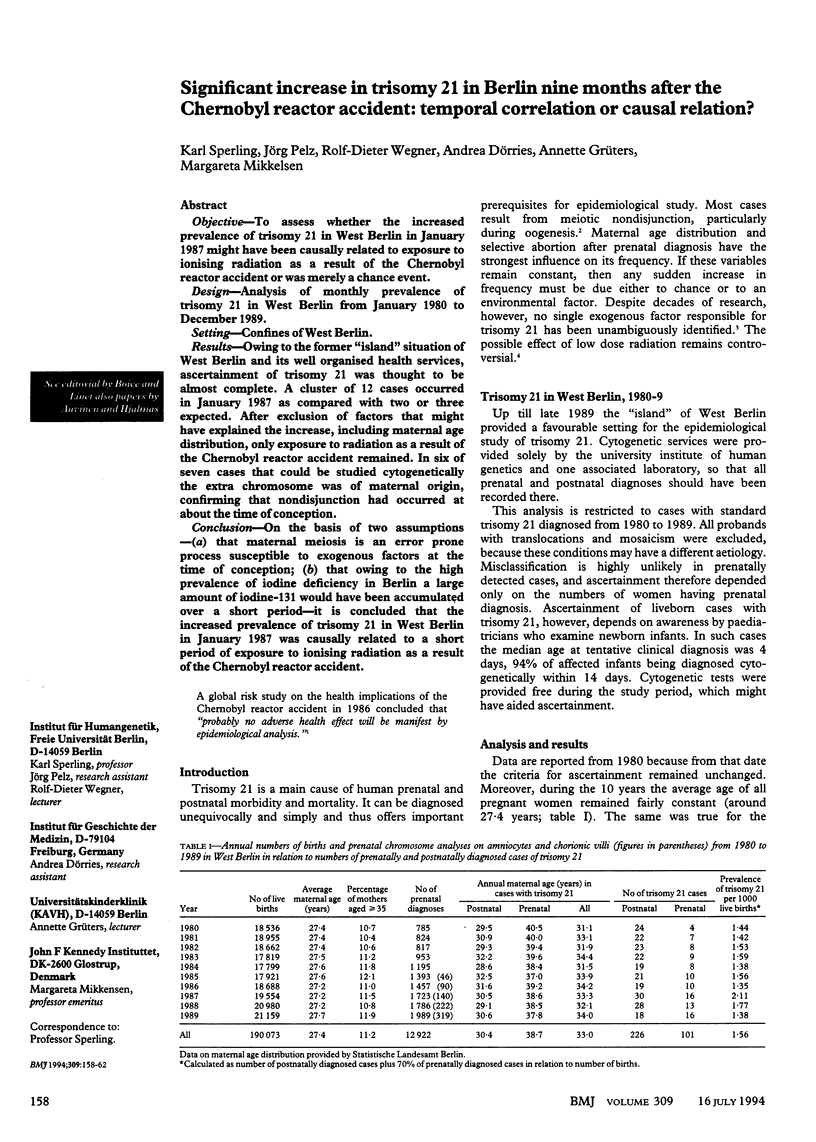
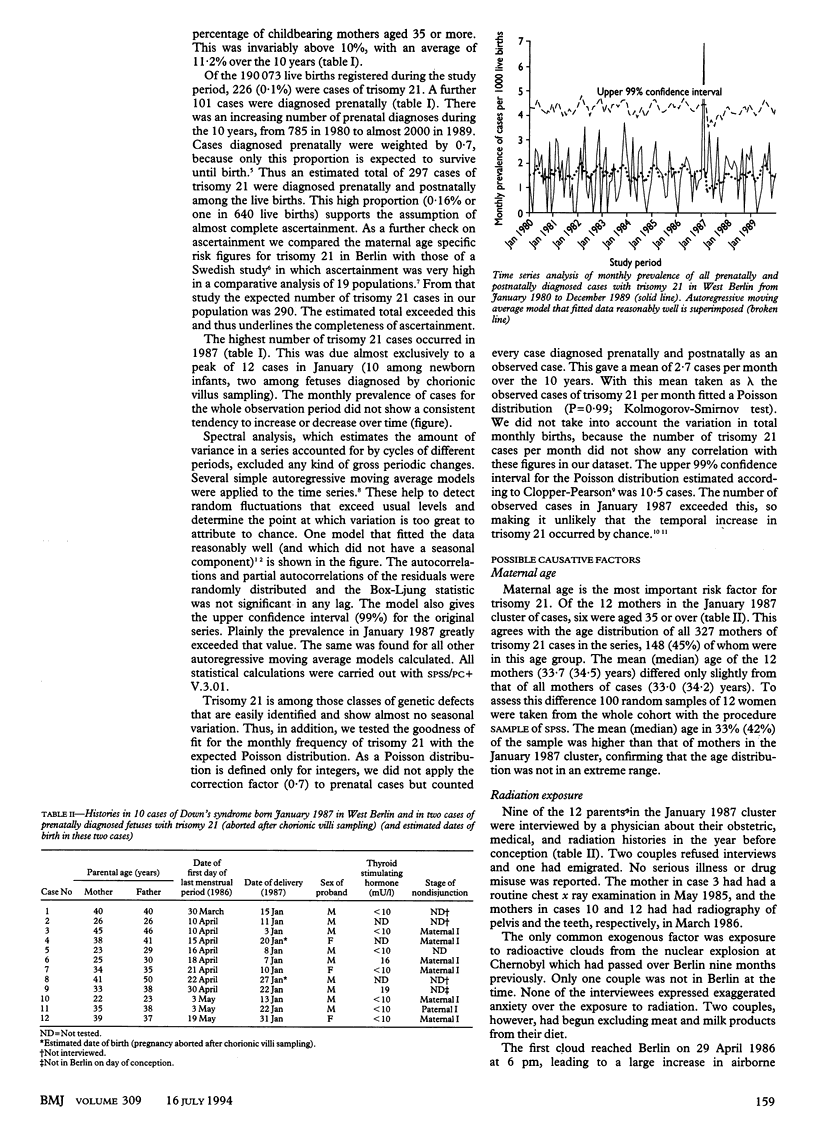
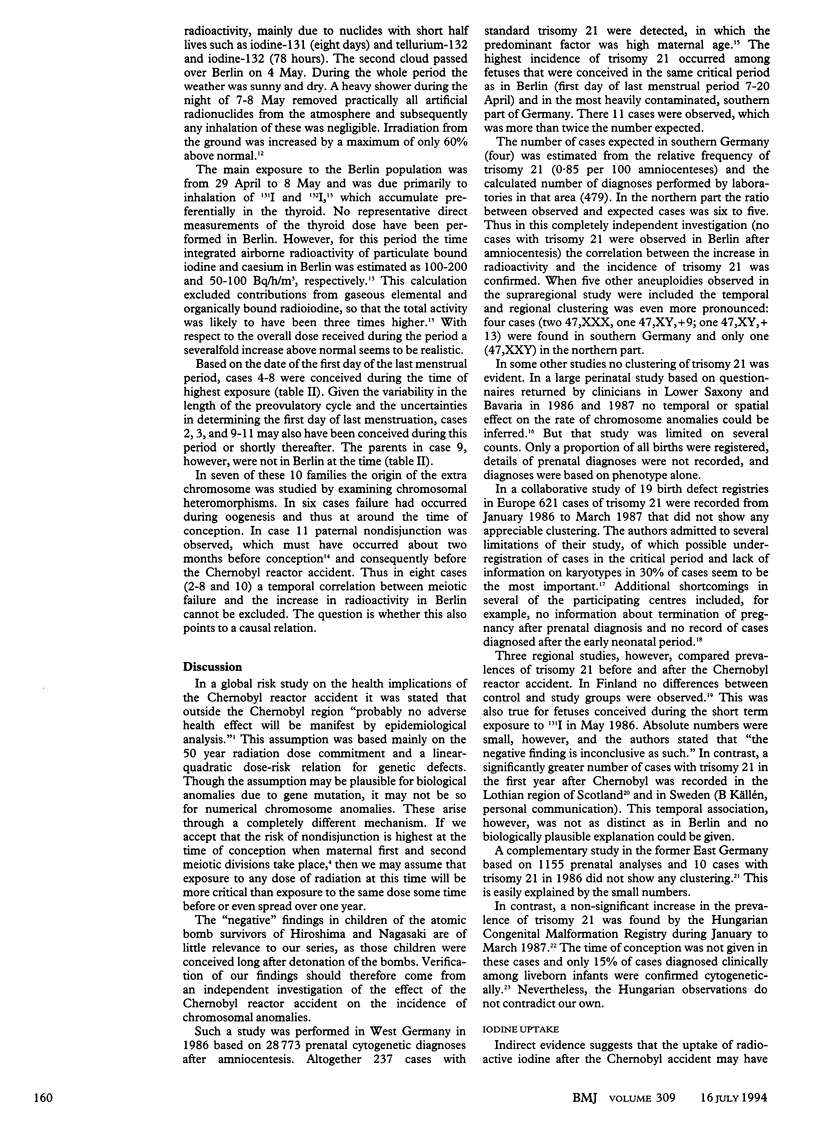
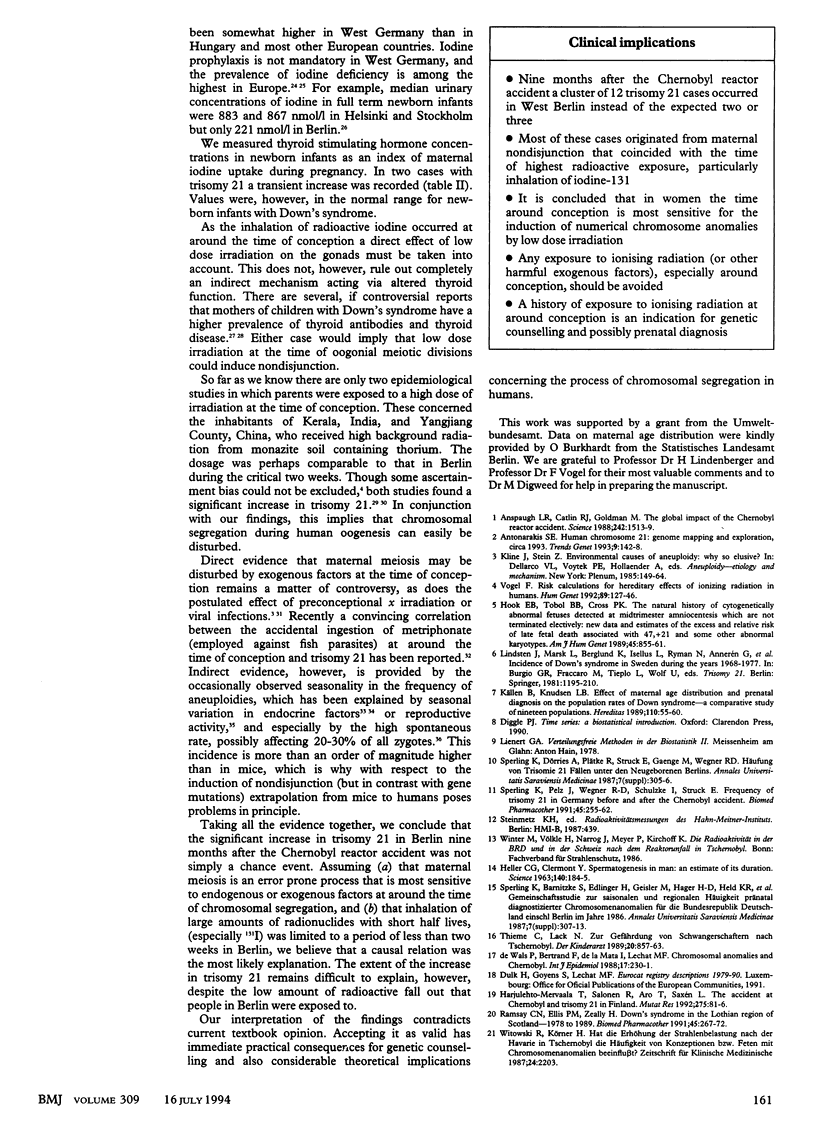
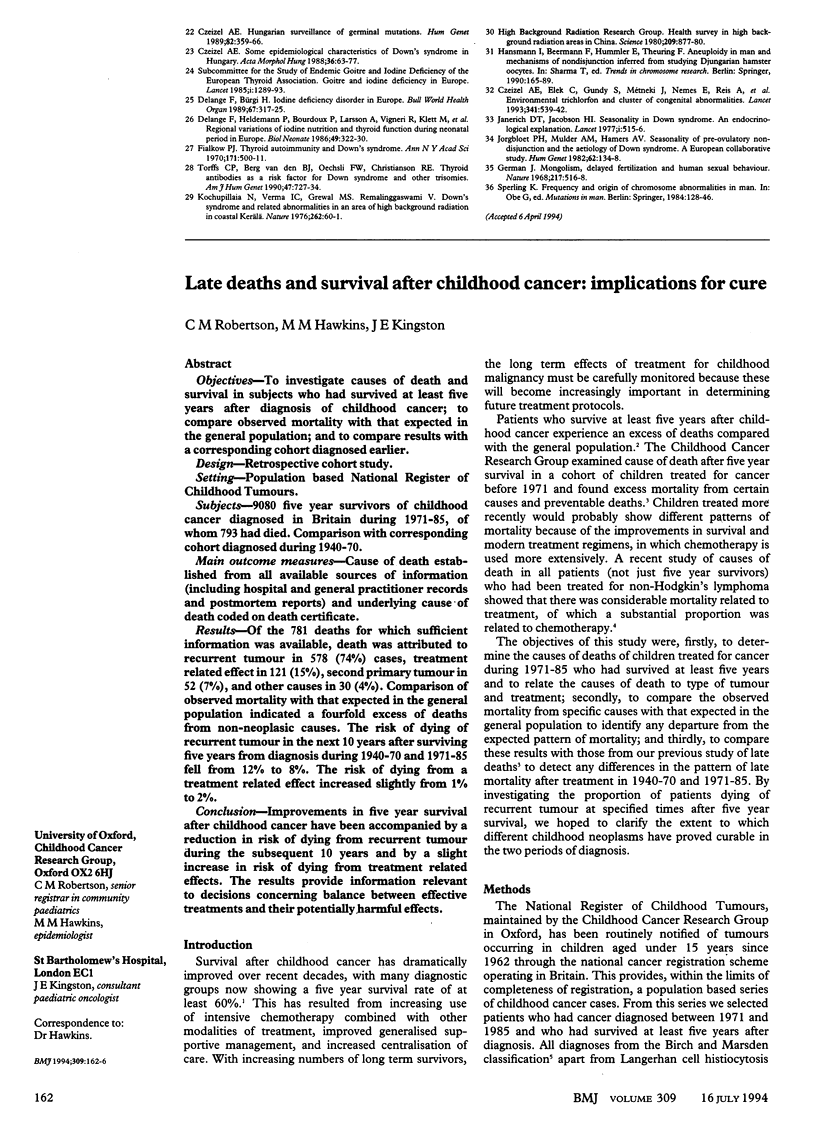
Selected References
These references are in PubMed. This may not be the complete list of references from this article.
- Anspaugh L. R., Catlin R. J., Goldman M. The global impact of the Chernobyl reactor accident. Science. 1988 Dec 16;242(4885):1513–1519. doi: 10.1126/science.3201240. [DOI] [PubMed] [Google Scholar]
- Antonarakis S. E. Human chromosome 21: genome mapping and exploration, circa 1993. Trends Genet. 1993 Apr;9(4):142–148. doi: 10.1016/0168-9525(93)90210-9. [DOI] [PubMed] [Google Scholar]
- Czeizel A. E., Elek C., Gundy S., Métneki J., Nemes E., Reis A., Sperling K., Tímár L., Tusnády G., Virágh Z. Environmental trichlorfon and cluster of congenital abnormalities. Lancet. 1993 Feb 27;341(8844):539–542. doi: 10.1016/0140-6736(93)90293-p. [DOI] [PubMed] [Google Scholar]
- Czeizel A. Hungarian surveillance of germinal mutations. Lack of detectable increase in indicator conditions caused by germinal mutations following the Chernobyl accident. Hum Genet. 1989 Jul;82(4):359–366. doi: 10.1007/BF00273998. [DOI] [PubMed] [Google Scholar]
- Czeizel E. Some epidemiological characteristics of Down's syndrome in Hungary. Acta Morphol Hung. 1988;36(1-2):63–77. [PubMed] [Google Scholar]
- Delange F., Bürgi H. Iodine deficiency disorders in Europe. Bull World Health Organ. 1989;67(3):317–325. [PMC free article] [PubMed] [Google Scholar]
- Delange F., Heidemann P., Bourdoux P., Larsson A., Vigneri R., Klett M., Beckers C., Stubbe P. Regional variations of iodine nutrition and thyroid function during the neonatal period in Europe. Biol Neonate. 1986;49(6):322–330. doi: 10.1159/000242547. [DOI] [PubMed] [Google Scholar]
- German J. Mongolism, delayed fertilization and human sexual behaviour. Nature. 1968 Feb 10;217(5128):516–518. doi: 10.1038/217516a0. [DOI] [PubMed] [Google Scholar]
- HELLER C. G., CLERMONT Y. Spermatogenesis in man: an estimate of its duration. Science. 1963 Apr 12;140(3563):184–186. doi: 10.1126/science.140.3563.184. [DOI] [PubMed] [Google Scholar]
- Harjulehto-Mervaala T., Salonen R., Aro T., Saxén L. The accident at Chernobyl and trisomy 21 in Finland. Mutat Res. 1992 Mar;275(2):81–86. doi: 10.1016/0921-8734(92)90011-d. [DOI] [PubMed] [Google Scholar]
- Hook E. B., Topol B. B., Cross P. K. The natural history of cytogenetically abnormal fetuses detected at midtrimester amniocentesis which are not terminated electively: new data and estimates of the excess and relative risk of late fetal death associated with 47,+21 and some other abnormal karyotypes. Am J Hum Genet. 1989 Dec;45(6):855–861. [PMC free article] [PubMed] [Google Scholar]
- Janerich D. T., Jacobson H. I. Seasonality in Down's syndrome. An endocrinological explanation. Lancet. 1977 Mar 5;1(8010):515–516. doi: 10.1016/s0140-6736(77)91375-7. [DOI] [PubMed] [Google Scholar]
- Jongbloet P. H., Mulder A., Hamers A. J. Seasonality of pre-ovulatory non-disjunction and the aetiology of Down syndrome. A European collaborative study. Hum Genet. 1982;62(2):134–138. doi: 10.1007/BF00282301. [DOI] [PubMed] [Google Scholar]
- Kochupillai N., Verma I. C., Grewal M. S., Ramalingaswami V. Down's syndrome and related abnormalities in an area of high background radiation in coastal Kerala. Nature. 1976 Jul 1;262(5563):60–61. doi: 10.1038/262060a0. [DOI] [PubMed] [Google Scholar]
- Källén B., Knudsen L. B. Effect of maternal age distribution and prenatal diagnosis on the population rates of Down syndrome--a comparative study of nineteen populations. Hereditas. 1989;110(1):55–60. doi: 10.1111/j.1601-5223.1989.tb00417.x. [DOI] [PubMed] [Google Scholar]
- Lindsten J., Marsk L., Berglund K., Iselius L., Ryman N., Annerén G., Kjessler B., Mitelman F., Nordenson I., Wahlström J. Incidence of Down's syndrome in Sweden during the years 1968-1977. Hum Genet Suppl. 1981;2:195–210. [PubMed] [Google Scholar]
- Ramsay C. N., Ellis P. M., Zealley H. Down's syndrome in the Lothian region of Scotland--1978 to 1989. Biomed Pharmacother. 1991;45(6):267–272. doi: 10.1016/0753-3322(91)90028-r. [DOI] [PubMed] [Google Scholar]
- Sperling K., Pelz J., Wegner R. D., Schulzke I., Struck E. Frequency of trisomy 21 in Germany before and after the Chernobyl accident. Biomed Pharmacother. 1991;45(6):255–262. doi: 10.1016/0753-3322(91)90026-p. [DOI] [PubMed] [Google Scholar]
- Torfs C. P., van den Berg B. J., Oechsli F. W., Christianson R. E. Thyroid antibodies as a risk factor for Down syndrome and other trisomies. Am J Hum Genet. 1990 Oct;47(4):727–734. [PMC free article] [PubMed] [Google Scholar]
- Vogel F. Risk calculations for hereditary effects of ionizing radiation in humans. Hum Genet. 1992 May;89(2):127–146. doi: 10.1007/BF00217113. [DOI] [PubMed] [Google Scholar]
- de Wals P., Bertrand F., de La Mata I., Lechat M. F. Chromosomal anomalies and Chernobyl. Int J Epidemiol. 1988 Mar;17(1):230–231. doi: 10.1093/ije/17.1.230. [DOI] [PubMed] [Google Scholar]


